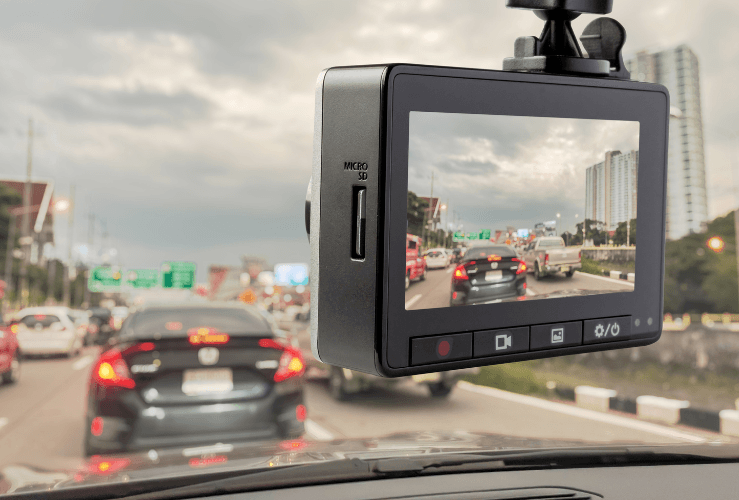An in-depth look at how to develop a fleet safety plan for your company - covering everything from identifying goals to final implementation.
Today's fleet managers must protect their drivers, company and assets from a diverse range of threats and risks. From ensuring vehicles are kept in good working order, to providing ongoing training to drivers, to harnessing the latest safety tech - the fleet manager's safety to-do list is seemingly endless.
With so many potential issues, today's fleet manager needs a robust and comprehensive fleet safety plan. But while many fleet managers face similar challenges, there is no one-size-fits-all approach to fleet safety.
There will be aspects of a company's safe operation that are unique to that organisation and which must be carefully mitigated against within the overarching safety plan.

Why is a fleet safety plan so important?
Below is a list of areas where a robust fleet safety plan can have a positive impact.
- Keep drivers safe: accidents can lead to life-changing injuries or even death.
- Avoid employees missing work due to injury (and having to find replacement drivers).
- Reduce the chances of legal action being taken against your company following an accident.
- Reduce fleet downtime: an accident can put a vehicle or piece of equipment out of action for weeks, months - or permanently.
- Reduce repair costs: by performing regular safety and maintenance checks, problems will be identified sooner, rather than developing into more serious, costly issues.
- Avoid towing costs: these can be substantial following a breakdown or collision (which may have been avoided with better maintenance or training).
- Maintain regulatory compliance: Many of the regulations concerned with fleet management/road transport relate to aspects of safety. A rigorous fleet safety plan can help maintain the relevant compliance certificates.
- Retain drivers: Many drivers want to work in a company with high safety standards because that means a safer working environment, and a more stable company that cares about the futures of its drivers and itself. It also means that with safety systems like dash cam recordings, they have backup in the case of legal problems (e.g., proving who was responsible for a particular accident).
- Reduce insurance costs: Vehicle insurance remains one of the most expensive aspects of running a fleet. But with an effective fleet safety plan, collisions and other accidents should be reduced, potentially resulting in lower insurance costs in the long term. Additionally, the introduction of certain safety features such as dashcams, in-cabin cameras, and other telematics systems, may also result in insurers giving you a better deal.
- Maintain data security: Some cutting-edge safety systems take in a huge amount of operational or driver information - and some of that can be sensitive. A fleet safety plan should extend into the digital realm, with sufficient checks and balances in place.
- Help maintain profit margins: With fewer write-offs, repairs, vehicle downtime periods, driver resignations, and legal actions, the company's profit margins should be higher over time.
- Maintain reputation and client base: Other companies want to work with fleets that have an excellent safety record and safety processes.

How to develop a fleet safety plan
Create a vehicle maintenance schedule
When a vehicle is not properly maintained, the chances of a breakdown or accident increase. Brakes, oil, coolant, and tyres must all be checked on a regular basis - among many other aspects of vehicle health.
Instituting a detailed vehicle inspection checklist - whether carried out in-depot or by the driver on-the-road - will help identify problems before they become serious. When an issue reaches a certain point, it could lead to expensive repairs or even put the safety of the driver and other road users at risk.
Your maintenance schedule must become part of your team's routine - just as important as getting vehicles from A to B on schedule.
Define specific goals
It's a good idea to have precise objectives when drawing up a fleet safety plan. Do you want to reduce risky driver behaviours by ‘x’ percent over the next 12 months? Do you want to cut accidents by a certain amount?
After identifying your goals, lay out how you plan to tackle these issues - such as with extra training, clear rules and policies, harnessing certain apps or tools, and/or improved communications with drivers.

Implement your safety programme and get 'buy-in' from drivers
- Be as transparent and clear as possible when communicating your safety plan to drivers and other staff.
- Set expectations and lay out what will happen if they are not met.
- Make it clear to drivers why the safety policy is so important (i.e., keeping them safe and helping the company to prosper).
- Keep all staff updated with any changes to the safety policy.
Installing driver-facing cameras
Note that some drivers may resist the idea of having a camera in their cabin. This is due to privacy concerns, or worries that unscrupulous employers might use it to exploit their drivers. They can be particularly contentious among long distance drivers, who effectively live in their cab. Their use may therefore constitute a more egregious breach of privacy.
You must inform a driver that a driver-facing camera has been installed and you should gain consent from them. Simply installing a camera without consulting the driver can result in a loss of trust between driver and employer.
There are many cases of unconsulted drivers unplugging or covering cameras they were not told were there.
Consider rewards and incentives to develop a positive driver safety culture
Look at ways to improve driver safety culture within your company.
You might offer rewards and incentives for those who best adhere to safety rules. While having a 'driver of the month' and publicising them in the company magazine (if there is one) is a little alien to UK companies (compared to US counterparts), it could be an effective way of promoting safe driving.
Additionally, a ‘safe driver’ can be determined by hard data, rather than any less reliable factors.
Harness the latest road safety technologies
A vast range of technologies have been adapted or developed for the fleet management industry in recent years. These are largely focused on monitoring driver behaviour and safety; fuel management; maintenance scheduling; and GPS tracking.
These technologies doubtless improve safety and efficiency, while keeping costs down (through less downtime, reduced fuel use, avoiding legal problems etc.).
Some of the following technologies will be installed as standard on modern vehicles, while others involve additional investment - often in the form of subscriptions and equipment installation.

Common fleet management safety technologies
- Telematics - these systems gather information on how a vehicle is being driven, including data such as speed, acceleration, braking, as well as location.
- Dashcams - modern dashcam systems are able to monitor what's happening ahead and/or behind the vehicle (including deliveries/pickups). Some systems also monitor what's happening inside the cabin. Video recorded by front, rear and/or in-cabin cameras can be used for various purposes, including as evidence after an incident, and to monitor how well a driver is controlling a vehicle. Some systems can transmit the video feed constantly in real-time via wifi, while others only start recording in particular circumstances - such as when the brakes are applied heavily. Drivers might receive coaching when their driving falls below expectations.
- Collision avoidance systems - these systems harness cameras, sensors and other technology to determine if the vehicle is too close to another and apply the brakes automatically.
- Fatigue monitoring systems - driver fatigue is a key safety concern. With these systems, symptoms of driver fatigue are monitored by cameras. They detect behaviours such as drooping eyelids and erratic driving - and can send an alert to the fleet manager.
- Automatic braking - also known as automatic emergency braking (AEB), this system uses radar and cameras to identify a hazard, and can slow down or stop a vehicle if a collision is likely.
- Adaptive cruise control (ACC) - this technology uses radar and cameras to monitor and adjust speed, helping to maintain a safe distance from the vehicle ahead. It is able to slow or stop the vehicle, then resume the journey.

Teach defensive driving skills
Ongoing training can help your drivers identify potential on-the-road hazards - and avoid falling into bad habits.
Good defensive driving skills can also lead to:
- Cost savings: With better driver skills, collisions and other incidents will be reduced, therefore saving your company in terms of repairs/vehicle replacements - and legal liability.
- Enhanced productivity: With better defensive driving skills within your team, the challenges will be resolved or mitigated more quickly, resulting in less vehicle downtime - and better productivity.
- Improved reputation: As with most businesses, reputation is everything within road transport and logistics. By delivering ongoing safety training to your drivers, you are communicating to current and potential customers that the safety of drivers and other road users is a top priority - and that you are a responsible company.
Understand your data protection responsibilities
As an employer, your company is likely to hold and process personal information of drivers and other staff members. It is critical this information is handled in accordance with data protection and GDPR legislation.
Given the large fines handed out to companies who fail to comply, not to mention potential reputation damage, effective data management is of prime importance to modern fleets and should be incorporated into any fleet safety plan.



